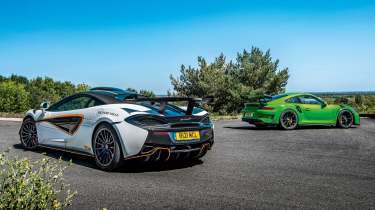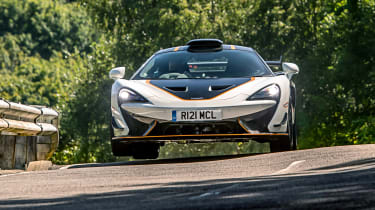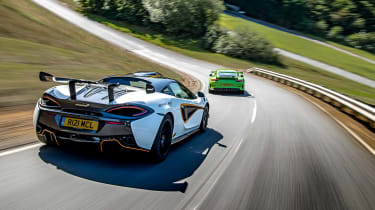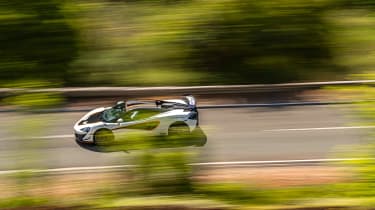McLaren 620R v Porsche 911 GT3 RS – Woking tackles Stuttgart's best
McLaren’s 620R wants a seat at the road racer top table. To earn it, it has to compete with the very best in the class. Bring on Porsche’s 911 GT3 RS…
If you’re going to gauge the success of a newcomer to the road racer genre you don’t need a racetrack or a stopwatch. What you need is decent roads and a Porsche 911 GT3 RS. Not because it’s the fastest, most powerful or even the most extreme car in its class, for it is none of these. You need a GT3 RS because in 991.2 spec it’s the product of two decades of dynastic dominance and a respected benchmark of the things we hold dear as drivers.
The products of differing doctrines, yet united by the same shared objectives, both the 620R and GT3 RS crystallise the thrill of driving like few other cars money can buy. As such they continue a fine tradition of uncompromising road cars that have long been the lifeblood of this magazine. If you love the notion of special cars built in small numbers by enthusiasts for enthusiasts, they possess a magnetism that’s hard to resist.
As a result you approach each with a sense of childish glee. Lashings of Lizard Green paint helps, and looks better than the 620R’s stripes, to my eyes at least. What both share is an abundance of functional details. It’s these that transmit the deliciously mixed messages of cars wearing full race battledress along with a registration plate.
> Final McLaren 620R rolls off production line, concluding Sports Series production
After the spartan confines of the 620R there’s something reassuringly familiar about getting settled behind the wheel of the GT3 RS. Slide the seat back and forth on its runners until your legs are crooked just so at the knees, then adjust the steering wheel for height and reach, using the old race school method of resting your wrist on top of the steering wheel. Wriggle your butt a little further down in the seat, then twist the ignition key and wait for the flat-six to settle into its rasping, slightly flatulent idle.
There’s a refinement to the RS that’s absent in the 620R. It comes as a surprise because I’ve always regarded the RS as a hardcore, pared-back machine. Carpets (albeit lightweight) and soft-touch trim contrasts with the McLaren’s brittle and exposed interior, so even though there’s a hefty half-cage filling the rear of the passenger compartment in this Weissach-spec example, the 911 feels well appointed. The softer, saner option, if you like.
It has taken the 620R to make me see it, but if there’s a criticism you could level at the RS it’s that it feels like it’s part of a model range and not an extreme outlier or true racetrack refugee. It would only take Porsche to offer a small number of stripped-out but road-legal GT3 RSs that echo old-school, bare-knuckle machines such as the 964 RS Cup to reassert itself, but if a truly authentic road racer demands its owner endures a little extra hardship then the 620R has the edge here. The scales suggest there’s less in it than you might think, with kerb weights of 1386kg for the 620R and 1430kg for the RS.
If you need reminding of the RS’s hardcore credentials it comes courtesy of suspension that shares the 620R’s no-nonsense firmness and direct, unfiltered responses. It may have PASM switchable dampers (which effectively give you a choice of firm and really firm in this application), but there’s a sharpness and lack of isolation which mirrors that of the passively damped McLaren. This comes from the use of spherical joints, a race car hallmark that trades give for ultimate precision, and gives this 991.2 GT3 RS (and indeed the GT2 RS) its distinctive edge.
Compared to the 620R’s the RS’s steering is busier and lighter. If you come to the Porsche still dialled in to the McLaren’s weighty, steadfast steering then you’ll feel initially unsure of the 911, for its front end is more easily distracted by bumps, cambers and even pronounced road markings. Up the pace and you’ll grip the wheel tighter in an effort to hold the same laser-guided lines prescribed by the McLaren, but a stiff-armed style is actually counterproductive in this car. Instead you need to apply just enough torque and resistance to the wheel so that the RS can squirm and buck in your hands without you trying to completely check its movements. It takes a leap of faith to stick with it, and requires an acceptance that on less than smooth roads (and let’s face it all the UK’s roads are less than smooth) the 911 has a pinch of non-malicious disobedience. Consequently its trajectory is one maintained with lots of small adjustments. You don’t need to fight it, and with time you don’t even need to consciously react to it, but you do need to work with it if you and the car are going to forge a bond. ’Twas always the way with older 911s, and something this RS reintroduced.
Handling-wise the 620R is dominated by a front end that’s extraordinary in its bite and response, and a rear end that’s entirely at one with that sensational ability to change direction. It puts less rubber on the road than the Porsche – 19-inch front and 20-inch rears wearing 225 and 285-section tyres respectively, compared with 20 and 21-inch items shod with 265s and 325s – but it feels pretty much unstickable, at least on the road.
Each end of the RS makes its own distinct contribution to the car’s overall feel, that busy front and keen-to-rotate rear combining to create a car that’s a little edgier and less conventional in balance terms, but still with masses of grip on which to lean. Confidence comes quicker in the McLaren, the learning process in the Porsche requiring more effort but delivering more satisfaction as a result. Both bring a sense of occasion and a level of feel and connection that make even the most mundane journey something to savour.
The biggest single point of difference between 620R and GT3 RS is their engines. In fact it’s the contrast between these two powerplants that lies at the heart of this twin test, the McLaren’s mid-mounted, torque-rich, turbocharged V8 up against the Porsche’s rear-slung, rev-hungry, naturally aspirated flat-six.
There’s a serrated yet silken quality to the RS’s 4-litre motor that’s little short of miraculous. Its 9000rpm reach is something to behold, so whilst peak outputs of 513bhp at 8250rpm and – perhaps more tellingly – 347lb ft at 6000rpm are very special indeed, they reveal a deficit of 98bhp and 110lb ft – peaks which arrive usefully earlier in the 620R, though, at 7500rpm and 5500rpm respectively, perhaps not as early as you might expect.
> The curious case of the missing Porsche 911 GT3 – evo Archive
Before you say it, yes, Porsche has the 620R covered with the monstrous GT2 RS (690bhp at 7000rpm and 553lb ft from 2500rpm), but as this test centres on the sensory, cerebral and emotional aspects of the road racer you’ll forgive us for not subjecting you to a toe-to-toe Top Trumps-style slugfest.
McLaren’s twin-turbo V8 has always been something of a steely eyed propulsion system rather than some symphonic source of pleasure. The blistering performance it bestows upon the 620R is undeniable, but the brusque manner by which it does so suggests McLaren paid perfunctory heed to offering much in the way of heart and soul. In the GT3 RS you believe Porsche knew it would have failed in its mission if the car didn’t offer the added wow factor of its screaming flat-six. Wrung-out for all it’s worth this extraordinary engine is an aria to natural aspiration. Of course, you have to work it harder than the 620R’s heavily boosted V8, and it can’t match the McLaren for mid-range muscle. But what you lose in the ability to render yourself lightheaded with brute longitudinal force, you gain in a sustained, ever-increasing and all-encompassing rush towards that elevated 9k red line.
So far as brakes and transmissions are concerned there’s very little in it. There’s something more satisfyingly mechanical about the McLaren’s upshifts that feels more physical yet still unerringly precise. The micro punches of the Inertia Push system, perhaps? Then again there’s something equally enjoyable about the RS’s PDK downshifts, which deliver a fabulous whapp-whapp-whapp of rev spikes as you punch down the ’box. We often eulogise about the joys of manual gearboxes, and with good reason, but there’s no denying the adrenalised intensity of both 620R and GT3 RS is in large part due to the synaptic speed with which they change gear.
Both cars are stopped by carbon-ceramic braking systems, the Porsche’s coming as an option, not as standard. At 410mm front and 390mm rear it bests the McLaren’s 390mm front and 380mm rear rotors, but both cars employ colossal six-piston calipers on the front and four-piston items at the rear.
McLaren positions the brake pedal of all its cars to suit left-foot braking. An admirable commitment to, er, commitment, and possibly most appropriate in a car such as the 620R, but it’s less satisfactory for those of us who use our right foot, as the pedal location forces you to twist your pelvis slightly in the seat if your foot is to settle on the meat of the pedal. The Porsche’s pedal positioning is conventional and more comfortable as a result. In terms of response and progression there’s very little in it, with both offering massive ultimate stopping power when you’re hefting on the pedal, but more than enough finesse to work very nicely at road speeds.
Finally, and sadly, due to a combination of the continuing – but hopefully temporary – spectre of Covid, and the permanent scourge of circuit noise restrictions, no suitable venue was available for us to compare these two on track. It would have been fun to try the pair on like-for-like road tyres and go for lap times, if only to satisfy our curiosity. There’s little doubt the lighter and more powerful McLaren would have proved quicker (though by how much I wouldn’t like to say), but I’m equally sure the Porsche would have ultimately been the more expressive and entertaining.
So which would I choose? The Porsche, but only by a whisker. ‘Surprise, surprise,’ I hear you groan. But hold on a minute. The only reason I’d take the Porsche is because of its scintillating engine. In every other respect there’s so little to choose between the pair I could make an equally strong case for going with the McLaren. To put it another way, it’s so close that I’m pretty certain had the similarly suspended and significantly more potent GT2 RS stood in for the GT3 RS I would have picked the 620R. It really is that special.
Woking has taken a lot of stick for the volume and frequency of the new models it releases. Rightly so on a certain level, for nobody wants a supercar maker to seem like a sausage factory. Then again if that’s the strategy it took to launch and sustain a brand that has achieved so much and evolved its cars so far in such a relatively short space of time, then perhaps it’s time to appreciate the scale of that achievement and enjoy seeing McLaren rattle the established marques.
McLaren has made more rounded cars than the 620R, just as it has made more extreme cars. What it has never done is built a car that expresses an understanding of what’s expected and required of a true road racer quite so eloquently, nor hit the sweet spot quite so accurately. This car is as authentic as the Senna – spectacular though it may be – is contrived. Quicker and more hardcore than a GT3 RS. More feelsome and characterful than a 488 Pista. Way more exclusive than either, and executed in an authentic and emphatically McLaren fashion. Allow that to sink in and you’ll see why the 620R is an absolutely stellar effort, and a fitting way to bring this remarkable chapter of McLaren Automotive’s young life to a close.
McLaren 620R
| Engine | V8, 3799cc, twin-turbo |
| Power | 611bhp @ 7500rpm |
| Torque | 457lb ft @ 5500-6500rpm |
| Weight | 1386kg |
| Power-to-weight | 448bhp/ton |
| 0-62mph | 2.9sec |
| Top speed | 200mph |
| Basic price | £250,000 |
Porsche 911 GT3 RS (991.2)
| Engine | Flat-six, 3996cc |
| Power | 513bhp @ 8250rpm |
| Torque | 347lb ft @ 6000rpm |
| Weight | 1430kg |
| Power-to-weight | 364bhp/ton |
| 0-62mph | 3.2sec |
| Top speed | 193mph |
| Basic price | £141,346 |







